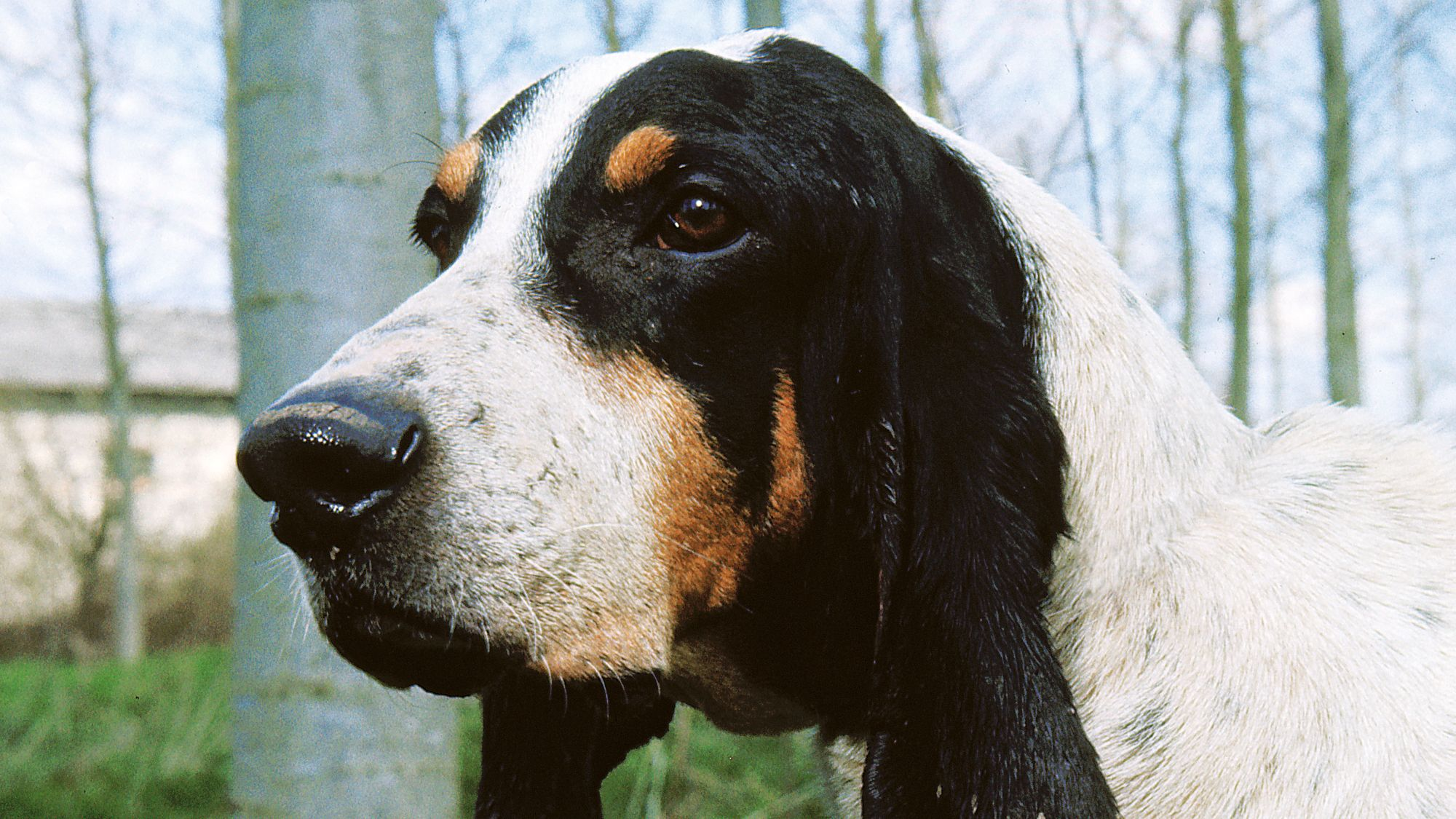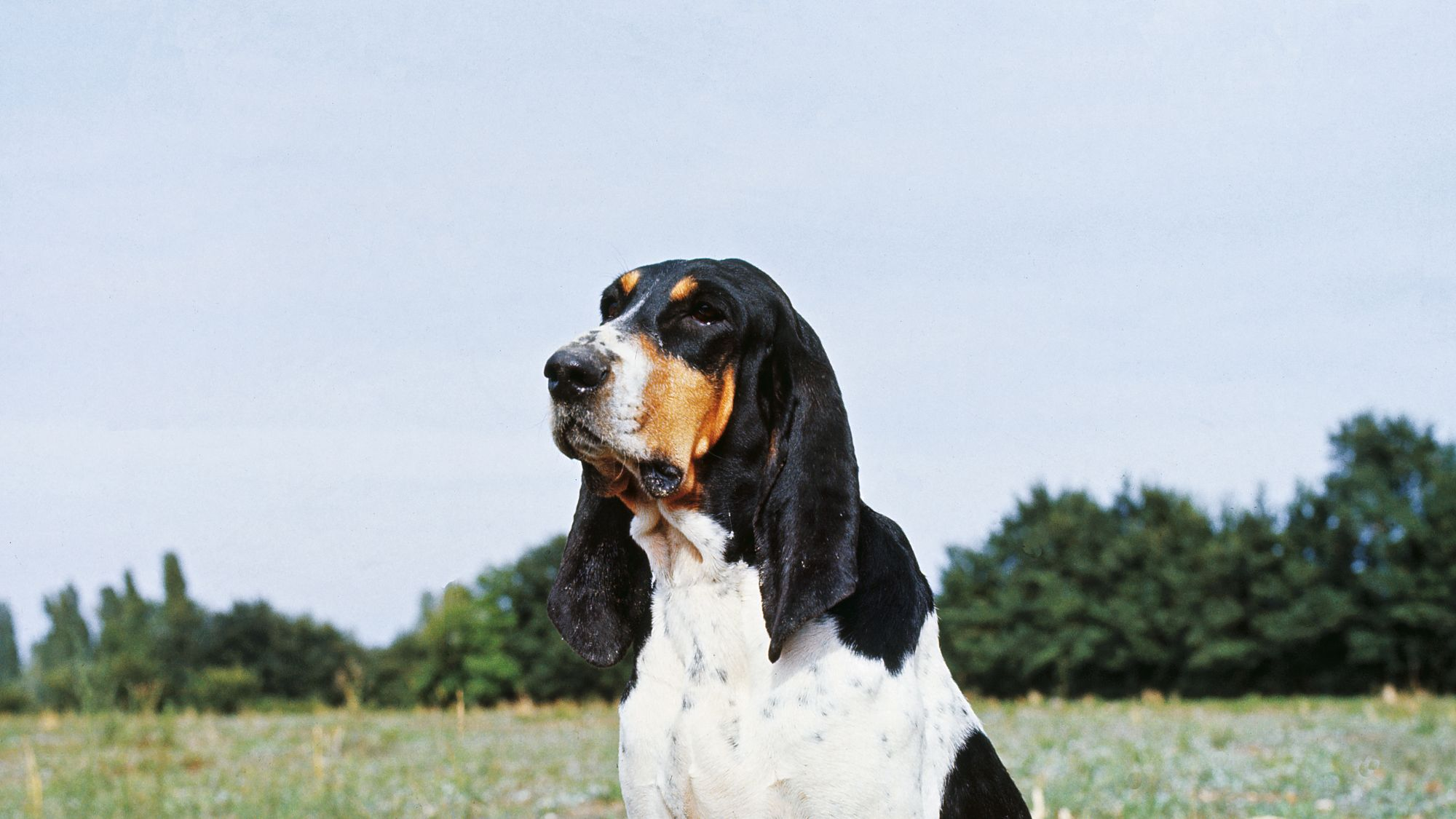
Let's talk Gascon Saintongeois dogs
Strength, stature and a very French élégance sum up the Gascon Saintongeois. This large hound breed (which also exists in a smaller format) with a powerful nose and a smooth coat in shades of black, white and tan, dates back to the middle of the 19th century in France. These dogs were originally bred for hunting as part of a pack. Nowadays their calm and docile temperaments also make the Gascon Saintongeois breed a good choice for active, outdoors-loving families: Those long strong legs need to run.
Official name: Gascon Saintongeois
Origins: France

| Drooling tendencies: |
|
Warm weather? | 
|
| Shedding level | 
|
Suited to apartment living? | |
| Energy level (high, low, moderate) *: | Moderate | Family pet? * |
|
| Compatibility with other pets: | Can stay alone? * |
* We advise against leaving pets alone for long stretches. Companionship can prevent emotional distress and destructive behaviour. Speak to your veterinarian for recommendations.
Every pet is different, even within a breed; this snapshot of this breed’s specifics should be taken as an indication.
For a happy, healthy and well-behaved pet, we recommend educating and socialising your pet as well as covering their basic welfare, social and behavioural needs.
Pets should never be left unsupervised with a child.
All domestic pets are sociable and prefer company. However, they can be taught to cope with solitude from an early age. Seek the advice of your veterinarian or trainer to help you do this.


| Baby age: | Birth to 2 months |
| Puppy age: | 2 to 15 months |
| Adult age: | 15 months to 5 years |
| Mature age: | 5 to 8 years |
| Senior age: | From 8 years |

1/7
Get to know the Gascon Saintongeois
All you need to know about the breed
With their big brown eyes and outsize floppy ears, not to mention a smooth, sometimes speckled coat in shades of black, tan and white, the Gascon Saintongeois is undoubtedly a beautiful breed. But they have much more to offer than aesthetics: These large powerful hounds were developed for their tracking abilities and endurance but make tranquil companions at home—provided they get enough exercise.
Gascon Saintongeois dogs were bred to be part of a pack so you should find them to be gregarious companions, at ease with their humans and with other dogs. The flipside is that they do not take well to being left alone for long periods.
They are not an ideal choice for households with small pets such as guinea pigs or hamsters—their prey drive is still strong. For the same reason, if they are let off the lead for exercise it needs to be in a safely enclosed space. Gascon Saintongeois dogs are a good-natured breed and respond well to training—just make sure any food rewards that you use come out of their daily rations to avoid them becoming overweight.

2/7
2 facts about Gascon Saintongeois dogs
1. Petit or grand?
If one Gascon Saintongeois doesn’t seem like quite enough dog, but two is too many—the good news is that the breed also comes in a smaller format. That’s thanks to selective breeding of the smallest dogs from Gascon Saintongeois litters. However, it must be said that the smaller version is still not tiny, weighing in at around 25kg (55lbs)
2. Rare breed
The Gascon Saintongeois may have a long and noble history but the breed is a relatively rare one and it is especially little known outside its native France. The breed is not recognised by the American Kennel Club (AKC) but the United Kennel Club recognised it in 1993.
History of the breed
The Gascon Saintongeois breed owes its existence to the demise of another. In the mid-19th century, a French count, Joseph de Carayon-Latour, set about trying to revive the declining Hound of Saintonge breed, by crossing the last descendants with examples of another breed, the Bleu de Gascogne belonging to Baron de Ruble (no wonder these dogs look so noble!). He didn’t quite get what he bargained for: Sadly, the Hound of Saintonge breed died out completely, but the good news was the emergence of the Gascon Saintongeois breed.
The new dogs on the block were immediately appreciated for their powerful noses, pleasing temperaments and stamina. The smaller version of the breed came about much later, in the mid-20th century, when a group of hunters from southwest France set about selectively breeding from the smallest dogs in their litters.

4/7
From head to tail
Physical characteristics of Gascon Saintongeois dogs
1. Ears
Large, fine, floppy ears hanging low, long muzzle.
2. Coat
Smooth coat, white with black and tan patches.
3. Tail
Strong, muscular build, thick tail tapering to the tip.

5/7
Things to look out for
From specific breed traits to a general health overview, here are some interesting facts about your Gascon Saintongeois

6/7
Caring for your Gascon Saintongeois
Grooming, training and exercise tips
Gascon Saintongeois dogs’ smooth short coats do not need an excessive amount of grooming—just a brush once a week should be enough. It’s a good idea to check their paws, ears and eyes after outings to check that no dirt or debris has got stuck. Their ears should be checked for wax build-up, which can lead to infections. Regular nail-trimming and frequent tooth-brushing are important too.
Gascon Saintongeois dogs need plenty of exercise—long walks and chances to play off the lead will be just right to keep them in good form, both physically and mentally. Make sure they are only let off the lead in a safely enclosed space: These strong dogs have plenty of stamina and impressive noses—if they pick up an interesting scent, they can run and run.
Training should be straightforward for the eager-to-please, intelligent Gascon Saintongeois—just make sure any food rewards are part of their daily rations, to avoid them becoming overweight. This is particularly important as they are large dogs and their joints may start to show signs of wear and tear as they age. Staying a healthy weight will reduce the workload on their joints.
7/7
All about Gascon Saintongeois dogs
Yes—as long as it’s an energetic family! Gascon Saintongeois dogs are quite sociable and content being near the rest of their pack (human or canine). They get on well with children, once trained, but like any breed should not be left unsupervised with them.
While the breed is not among those most known for excessive shedding, Gascon Saintongeois dogs do still lose hair during the spring/summer shedding season. They are a relatively easy breed to groom, with just a weekly brush enough to keep their short smooth coats in good order.
translations.feature.breeds.otherbreeds
Read more on this topic

How your dog's nutrition needs change with age

How to adopt a dog

Things to consider before getting a dog
Sources
1 - Veterinary Centers of America https://vcahospitals.com/
2 - Royal Canin Dog Encyclopaedia. Ed 2010 and 2020
3 - Banfield Pet Hospital https://www.banfield.com/
4 - Royal Canin BHN Product Book
5 - American Kennel Club https://www.akc.org/


